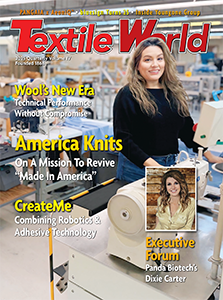WETZIKON, Switzerland— March 15, 2018 — Ibrahim Fibres Limited was founded by Sheikh Mohammad Ibrahim together with his sons Sheikh Mukhtar Ahmed and Sheikh Sardar Ahmed in August 1968 as “Ibrahim Agency Pvt Ltd” that later became instrumental in establishing one of the largest textile businesses in Pakistan, the Ibrahim Group.
Loepfe: What are IFL’s main products and on which key markets do you focus?
Mr. Zafar Iqbal Rana: Main products of Ibrahim Fibres Limited include; Polyester-Cotton combed blends (count range Ne 10-45) and Polyester-Viscose blends (count range Ne 18-66). The products offered by Ibrahim Fi-bres Ltd. are known and appreciated for their versatility as the produced yarn is perfectly usable for the weaving and knitting process. The experts at IFL are focused on providing quality conscious customers in the local mar-ket with the best. At the same time, we pay attention to the quality demands of our clients including all major fabric manufacturers & exporters.
Loepfe: What are the challenges to IFL today and in the future?
Mr. Zafar Iqbal Rana: IFL believes that nowadays cost-effectiveness and market competitiveness are the two key factors for the growth of any organization. Overall, we can say that the lack of digitalization and modernization of plant equipment is the fundamental factor for crises in Pakistan Textile Industry. By adapt-ing to modern equipment and techniques as well as the advanced philosophy at IFL, we are able to satisfy our customers with valued products while maintain-ing cost-effectiveness in operations. Moreover, IFL is also working purposely towards “Industry 4.0”. Other initiatives under consideration at IFL include multi-source self-power generation (HFO, Natural gas, Coal & National Grid). The possibility to mix sources for power generation makes it more economical.
Loepfe: IFL has a very interesting, for a spinning mill quite unusual, management philosophy. Could you please explain to us he main pillars of this philoso-phy? As an example, preventive maintenance is taken very seriously at your mill. What are the reasons and what kind of benefits results from it?
Mr. Zafar Iqbal Rana: Ibrahim Fibres Limited is based on the philosophy of “Exceeding customer expectation and strive for excellence in all spheres of our activities, and to manufacture high quality products through the use of advanced technology operations.” IFL is proud to be known as the leading manufacturer of staple fibers and yarns with consistently excellent results. Achieved through the “no compromise on quality” phi-losophy. To deliver high quality, IFL places an emphasis on selecting the best raw materials available. For exam-ple, world’s best Viscose from Lenzing and PSF from Ibrahim Fibres are used and processed with European technology. At the same time, emphasis is placed on the development of staff.
IFL carries out regular maintenance checks with routine observations and condition monitoring. The experts at IFL are keen to ensure and identify the problematic areas and parts to avoid any kind of technical issues which could lead to delivery delays or lower product quality. To ensure the quality standards, IFL also works with scheduled replacement of quality related genuine parts.
Loepfe: Pakistani cotton has serious contamination issues, how do you see Loepfe will be effective for Pakistani cotton?
Mr. Zafar Iqbal Rana: With no doubts, modern markets are concerned and highly sensitive about the quality of products. In such situations, contamination in Pakistani cotton is nothing less than a nightmare for the spinners. Despite the integration of automatic contamination sorting machines in opening and cleaning lines, foreign matter are still making their way up to the winding process. Therefore, it is indispensable for us to include optical based foreign parts detection sensors of Loepfe within our winding process.
Loepfe:
- Why have you continuously chosen to work with Loepfe?
- Did the principal of optoelectronic yarn monitor-ing, which measures, independent of changing ambient conditions, influence your decision?
- Apart from the technology and development of the yarn clearers and related central monitoring systems, perhaps there are also other decisive factors (service, people and support)?
Mr. Zafar Iqbal Rana: IFL believes that as a leading manufacturer of optical yarn clearing systems Loepfe is not only efficient in dealing with all types of yarn faults but also provides vital information regarding the yarn produced with precisely tailored reports which in turn leads to optimization of the entire process. Being a leading blended yarn manufacturer, we know that the optical yarn sensors made by Loepfe are less affected by TDO (Titanium dioxide) which is present in the polyester fibers.
Apart from all the technical product features and benefits, quick and easy access to support and service are also key factors enhancing the productivity of any plant.
Loepfe:
- Being the top of the line mill in Pakistan, IFL never compromise on quality.
- Could you please share with us your approach to yarn quality?
- How do Loepfe yarn & mill monitoring systems impact to further enhance IFL yarn quality?
Mr. Zafar Iqbal Rana: Consistent yarn quality with minimum defects has always remained a prime requirement of customers. For this reason, IFL always believes in using the latest quality control equipment on its machines. IFL believes that the detection and removal of yarn faults regardless of critical conditions and the unique foreign parts detection & removal tech-nology will surely serve to fulfill our commitments. In this regard, standard reports from the MillMaster TOP system are quite helpful in terms of quality monitoring. Here, we compare the data in both tabular as well as graphical format.
Thank you for the good cooperation and the valued and open communication. It’s always a constructive and interesting exchange which makes it easy to suggest & provide the right solutions. We are looking forward to many more years of this pleasing cooperation and hope that the crystal from the Swiss mountains delights you.» Mr. Joerg Mueller, Sales Manager Loepfe.
Posted March 15, 2018
Source: Loepfe Brothers Ltd.




